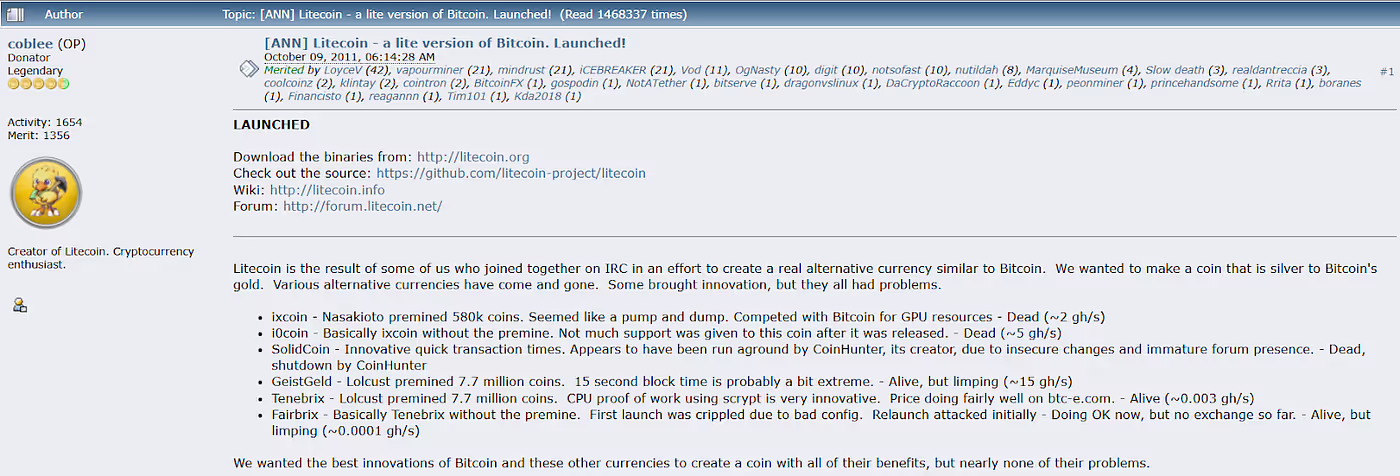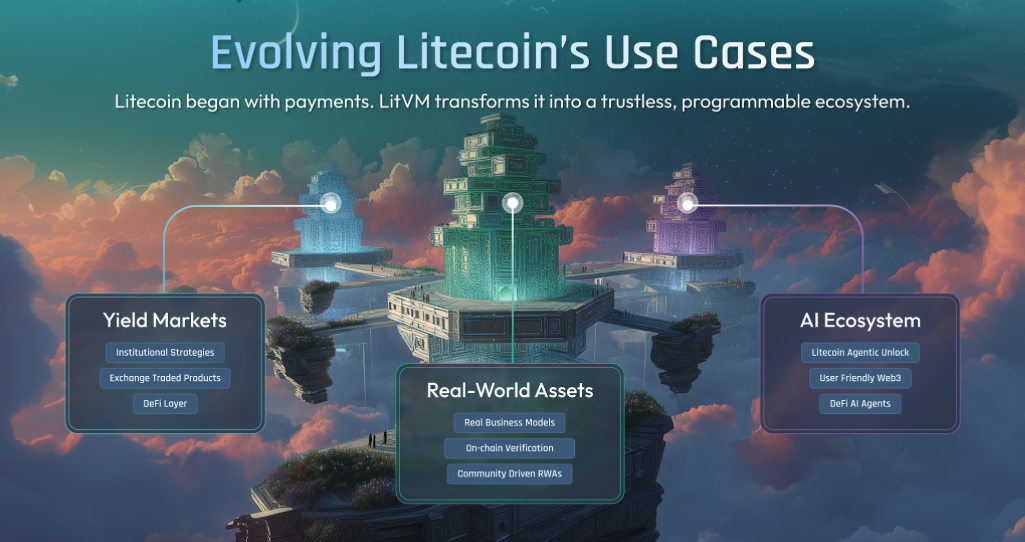If you’re just exploring LitVM for the first time, welcome!
You’ve arrived at the official LitVM blog — ground zero for all things LitVM, Litecoin, and the future of the on-chain world. To kick things off, LitVM is tracking Litecoin all the way back to its roots, and then all the way forward to its future. From its inception to its next phase of expansive scalability and Ethereum Virtual Machine (EVM)-powered potential, LitVM is here to prepare you for Litecoin’s forthcoming role as a leader in driving the adoption of decentralized technologies.
Without further ado, Litecoin’s backstory… and its next chapter.
{{separator}}
Litecoin’s First Steps
Litecoin first arrived on the digital asset scene on October 7, 2011 as an open-source client on GitHub, with the Litecoin network launching 6 days later on October 13. A crypto OG by any and all definitions, Litecoin was created by former Google Software Engineer Charlie Lee with a clear purpose: to tackle Bitcoin’s growing limitations. Lee’s goal was to build a cryptocurrency that remained true to Bitcoin’s core principles and value proposition while accelerating transactions and driving down fees for users. Rather than competing with Bitcoin, Lee aimed to create a complementary chain that would be able handle daily transactions and innovate on new features and functionality, while Bitcoin would act as an empirical store of value and robust option for larger capital transfers.

On that accord, Litecoin quickly came to life as one of the first and most successful cryptocurrency forks, offering a lighter alternative to Bitcoin and earning the label “the silver to Bitcoin’s gold”.
{{separator}}
Fulfilling Litecoin’s Preordained Mission
Litecoin built its foundation by forking Bitcoin’s codebase, thereby inheriting much of its predecessor’s architecture. However, Lee made several vital changes, dropping the block generation time to 2.5 minutes compared to Bitcoin’s 10 minutes, quadrupling the maximum supply to 84 million coins, and changing the mining algorithm from SHA-256 to Scrypt. Scrypt allowed Litecoin miners to use consumer-grade hardware at first, making it more accessible for wider onboarding and early expansion.
While Bitcoin inspired much of Litecoin’s development, Litecoin’s unique technical design elements have allowed its development team and community to fulfill a unique function in the Web3 ecosystem.
- Block Time and Transaction Speed: As opposed to Bitcoin’s 10-minute block times, Litecoin creates a new block every 2.5 minutes, allowing the Litecoin network to handle approximately 56 transactions per second (TPS) — substantially higher than Bitcoin’s 7.
- Mining Algorithms: While Bitcoin uses the SHA-256 hashing algorithm which requires specialized ASIC mining equipment and heavy computational power, Litecoin uses the Scrypt algorithm, which instead requires greater memory. Although specialized hardware exists for both coins today, Scrypt remains more accessible to individual miners and uses less energy overall.
- Terminal Supply and Inflation Models: Both Bitcoin and Litecoin follow similar disinflationary models, but Litecoin reaches a maximum supply of 84 million coins — four times more than Bitcoin’s 21 million cap. Litecoin halves approximately every four years, just like Bitcoin. But with a four-times faster block time, Litecoin has a four-times larger terminal supply.
- Merge-Mining: To provide miners with an additional incentive, Litecoin began supporting merged mining with Dogecoin in summer 2014. Miners can now mine both cryptocurrencies at once without losing performance, which creates a win-win situation for both chains, while increasing miner profits. Similarly, many other chains have enabled merged mining features with Litecoin — though none of the stature or market capitalization of Dogecoin.
{{separator}}
Key Milestones Driving Litecoin’s Trajectory
From its 2011 inception to today, Litecoin’s robust tech stack and burgeoning community have come a long way, thanks to a series of major developments. While it’s impossible to distill the entire 14-year journey into a few bullet points, 3 major technical milestones have highlighted Litecoin’s innovative technical potential.
- SegWit Activation: Litecoin became the first major cryptocurrency to activate Segregated Witness (SegWit) in May 2017. A breakthrough upgrade, SegWit improved network scalability by separating transaction signatures from transaction data. By successfully completing SegWit implementation, Litecoin paved the way for future innovations and demonstrated its capacity to implement technical improvements.
- Lightning Network integration: Litecoin added support for Lightning Network in May 2017 — almost a year before Bitcoin. Lightning’s second-layer solution made near-instant transactions feasible with minimal fees. Today, Litecoin’s Lightning Network has nearly 100 active nodes running across 170 channels. The Lightning Network not only improved speed, but also helped to establish atomic swaps between Litecoin and Bitcoin, improving cross-chain compatibility between crypto’s gold and silver.
- MimbleWimble and Privacy Upgrades: Litecoin implemented MimbleWimble Extension Blocks (MWEB) at block 2,257,920 on May 19, 2022. This optional privacy layer uses confidential transactions and transaction aggregation to enhance user privacy. MWEB helped Litecoin stand out from Bitcoin’s codebase and create its own identity in the digital world. With the help of MWEB, Litecoin has amassed more than 150,000 LTC on its privacy layer.
{{separator}}
Litecoin’s Role in the 2025 Crypto Ecosystem
In 2025, Litecoin has established itself as an integral component in the modern crypto ecosystem. Having operated reliably for more than a decade, Litecoin continues to attract users both as a store of value and a medium of exchange. All factors considered, a trio of key factors are driving Litecoin’s ongoing expansion.
- Merchant Adoption: Merchants and platforms choose Litecoin because of its solid reputation and technical benefits. Major payment processors like BitPay and CoinGate now support Litecoin payments, which allow thousands of merchants to accept LTC. Popular online retailers Newegg and Overstock accept Litecoin payments, while travel booking platforms such as Travala allow customers to book their flights and stays with LTC. Meanwhile, VPN services have embraced Litecoin, with NordVPN, ExpressVPN, and ProtonVPN all accepting LTC payments. Privacy-conscious users also choose Litecoin when seeking anonymous payment options.
- Peer-to-Peer (P2P) Payments: Litecoin is a premier digital asset for everyday transactions. Users pay approximately one cent in fees on average, and transactions complete in approximately 2.5 minutes. These figures have made Litecoin ideal for peer-to-peer transfers, facilitating simple transfers in cross-border scenarios, in areas with limited banking, and for easy payments to friends, family, and colleagues.
- Deep Crypto Integration: Last but not least, Litecoin lives at the heart of the crypto ecosystem. LTC is available on most premier cryptocurrency exchanges, including Binance, Coinbase, and Kraken, ensuring essential liquidity and market access. Leading hardware wallet makers Ledger and Trezor supported Litecoin from their earliest launches, and continue to support LTC storage as a primary feature in their latest models.
{{separator}}
LitVM: The Next Chapter of Litecoin
With nearly a decade and a half of innovation, growth, and adoption behind it, Litecoin has a lot more than a silver lining driving it forward. Today, Litecoin serves as both a unique technology and powerful payment solution complementing Bitcoin’s golden mission to democratize money.
With faster block times, a less computationally intensive mining algorithm, and cutting-edge innovations like MimbleWimble privacy features, Litecoin has proven beyond any doubt that it is far more than a mere testing ground for Bitcoin. Of course, markets continue evolving, and Litecoin’s next strides are poised to be its largest and most revolutionary yet.
The next phase for Litecoin focuses on two critical aspects: an enhanced network capable of handling global transaction volume and smart contract functionality to support a breadth of innovative on-chain applications. On both accords, LitVM has arrived in the Litecoin ecosystem at the perfect moment to answer the call.
Remaining true to both Bitcoin and Litecoin’s founding principles, LitVM offers a trust-minimized, decentralized omnichain designed to vastly improve scalability, provide interoperability with other major chains (including Bitcoin and Ethereum) and facilitate groundbreaking innovation via EVM smart contract compatibility. While Litecoin’s base chain will continue to operate based on its robust consensus and Scrypt mining algorithm, LitVM will kick performance into a new gear, allowing for the emergence of Litecoin-native DeFi protocols, advanced payment rails, Real-World Asset (RWA) infrastructure, AI-integrated consumer apps, and much more.

Meanwhile, as Bitcoin continues to serve as a settlement layer for larger transactions, LitVM will enable Litecoin to continue to serve as an uninterrupted lightweight network for everyday payments denominated in LTC.
While the LitVM and Litecoin communities alike can only imagine what the future has in store for Litecoin, one thing can be said for sure — it’s gonna be lit!
About LitVM
LitVM is Litecoin’s Virtual Machine, enabling smart contract capabilities and Web3 applications for Litecoin.
Officially endorsed by the Litecoin Foundation, LitVM is committed to fostering a 'sound money Web3’ ecosystem, including Litecoin yield opportunities, real-world assets, AI and more.





